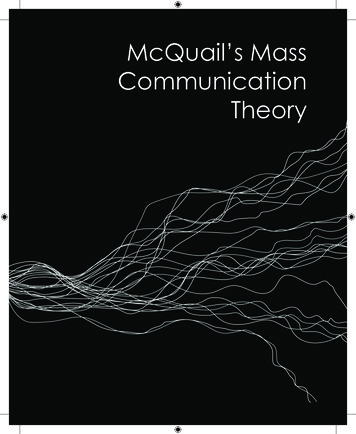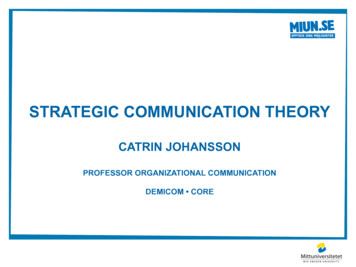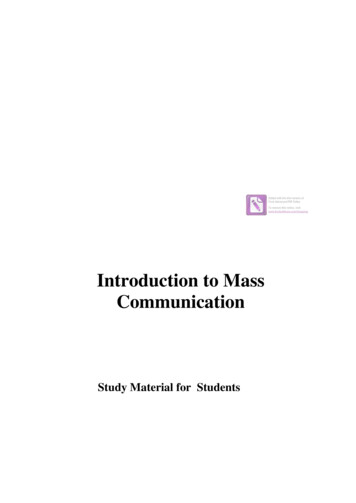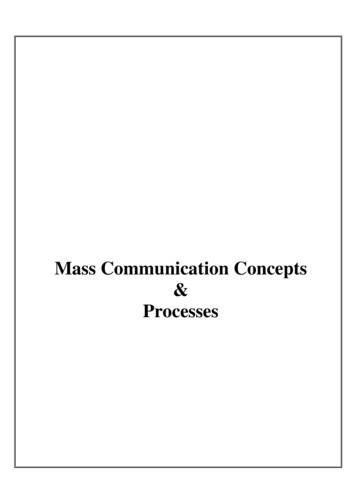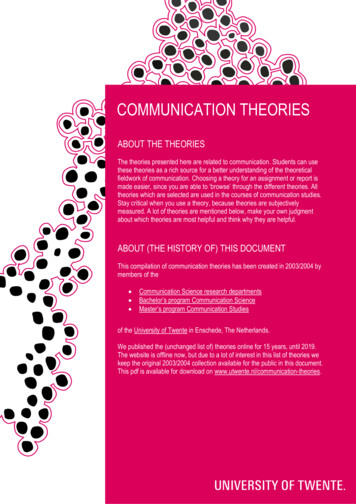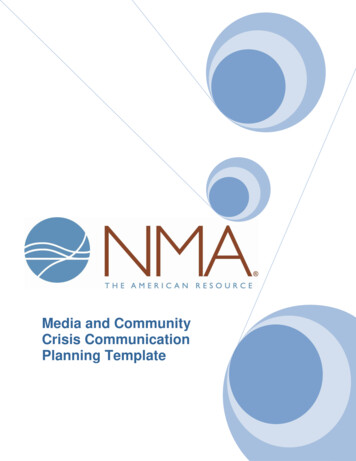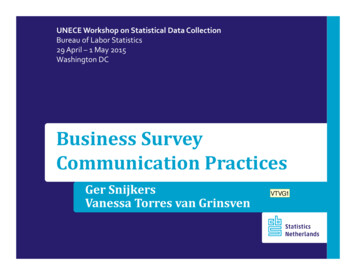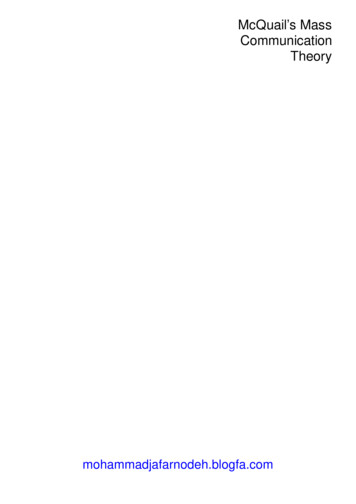
Transcription
McQuail’s om
Dedicated to the future media audiences, especially:Laurence, Alexander, William, Noah, Chaia, Alice, Miranda, Anarosa, and Ava, grand childrenall.
McQuail’s MassCommunicationTheory6th editionDenis McQuail
Denis McQuail 1983, 1987, 1994, 2000, 2005, 2010First edition published 1983Second edition published 1987Third edition published 1994Fourth edition published 2000. Reprinted 2001, 2002, 2003, 2005Fifth edition published 2005. Reprinted 2006, 2007, 2008, 2009Apart from any fair dealing for the purposes of research or private study, or criticism or review, as permitted under theCopyright, Designs and Patents Act, 1988, this publication may be reproduced, stored or transmitted in any form, or by anymeans, only with the prior permission in writing of the publishers, or in the case of reprographic reproduction, in accordancewith the terms of licences issued by the Copyright Licensing Agency. Enquiries concerning reproduction outside those termsshould be sent to the publishers.SAGE Publications Ltd1 Oliver’s Yard55 City RoadLondon EC1Y 1SPSAGE Publications Inc.2455 Teller RoadThousand Oaks, California 91320SAGE Publications India Pvt LtdB 1/I 1 Mohan Cooperative Industrial AreaMathura RoadNew Delhi 110 044SAGE Publications Asia-Pacific Pte Ltd33 Pekin Street #02-01Far East SquareSingapore 048763Library of Congress Control Number: 2009932171British Library Cataloguing in Publication dataA catalogue record for this book is available from the British LibraryISBN 978-1-84920-291-6ISBN 978-1-84920-292-3 (pbk)Typeset by C&M Digitals (P) Ltd, Chennai, IndiaPrinted and bound in Great Britain by TJ International Ltd, Padstow, CornwallPrinted on paper from sustainable resources
ContentsPrefaceHow to Use this BookPART 1 PRELIMINARIES1 Introduction to the Book2 The Rise of Mass MediaPART 2 THEORIES3 Concepts and Models for Mass Communication4 Theory of Media and Society5 Mass Communication and Culture6 New Media – New Theory?7 Normative Theory of Media and SocietyPART 3 STRUCTURES8 Media Structure and Performance: Principles and Accountability9 Media Economics and Governance10 Global Mass CommunicationPART 4 ORGANIZATIONS11 The Media Organization: Pressures and Demands12 The Production of Media CulturePART 5 CONTENT13 Media Content: Issues, Concepts and Methods of Analysis14 Media Genres and TextsPART 6 AUDIENCES15 Audience Theory and Research Traditions16 Audience Formation and ExperiencePART 7 EFFECTS17 Processes and Models of Media Effects18 Social-Cultural Effects19 News, Public Opinion and Political CommunicationPART 8 EPILOGUE20 The Future of Mass CommunicationGlossaryReferencesIndex
PrefaceThis version is an updating and consolidation of the last edition, building with more confidenceon the proposition that mass communication is evolving and becoming more complex ratherthan withering away. The earlier expectation of demise was based on the belief that the ‘newmedia’ of public communication that were appearing in the latter part of the 20th century wouldultimately prove to be superior in all respects to the relatively crude forms of traditional ‘massmedia’ (especially newspaper and television broadcasting). This supposition was itself out ofstep with the lessons of media history that has already demonstrated the power of differentmedia forms to adapt and survive in new environments. It is now the turn of the traditional massmedia to adapt to new technology under changing social, economic and cultural conditions.The persistence of mass communication as a process and the continued relevance of much ofthe accumulated theory and research stem, even so, from continuity in the kind and direction ofdominant social forces, especially those that fall under the headings of globalization andmodernization/development. In the same way that media of all kinds are converging, so alsoare theories of the new and old media converging.Despite the expectation that mass communication will evolve and survive, the changestaking place to, and within, the spectrum of public communication media are fundamental,accelerating and open for all to see. They outpace the capacity of a book of this kind to keeppace with what is happening on the ground. But the purpose, as before, is not to chart mediachange, but to provide some relatively firm theoretical islands or platforms from which toobserve and understand what is happening around us. The evidence for all this comesprimarily from the continuing stream of findings of academic research in media andcommunication, which is itself always anchored in and directed by theory, but also rather slowto appear. The main changes made in this edition have been motivated by the aims of testingthe continued relevance of old theory and of adding, where possible, to the stock of theory.Often it is reports about the effects and significance of new media that are most fruitful for thesecond purpose.A process of revision of this kind depends not only on scanning and evaluating newlypublished theory and new empirical evidence. It also calls for continuing contact with othersengaged in more active ways with the field of inquiry. I have been fortunate in having continuedopportunities for exchange of ideas and for learning new things from colleagues, friends andstudents. I cannot repay all debts, but I would like to mention here some of the people, placesand events that have been of particular help on the journey. I have been much helped, thanksto Karin Raeymackers, by ready access to the communication library of the University of Ghent,with its now rare collection of current and recent international journals. I have also appreciatedregular contact with my co-editors and others associated with the European Journal ofCommunication, especially Els de Bens, Peter Golding and Liesbet van Zoonen. The periodicseminars organized by the EJC have been an important learning experience. A continuing linkwith the Euromedia Research Group, by participation in meetings and publication, has beenanother source of stimulation (too many names to name). Another recurring source ofstimulation has been the chance to participate in the annual doctoral Summer Schoolorganized by the European Communication Research Association (ECREA) and held for thelast five years at the University of Tartu, Estonia. I have benefited also from invitations to teachor give lectures at a number universities. Particular thanks are due in this respect to Prof.Takesato Watanabe at Doshisha University, Kyoto. I have similar debts to Helena Sousa, at theUniversity of Minho, Potugal; Josef Trappel at the University of Zurich, Elena Vartanova atMoscow University Faculty of Journalism; Miquel de Moragas Spá at the Autonomous
University of Barcelona; Miroljub Radoikovich, University of Belgrade; Konca Yumlu at EgeUniversity, Izmir; Vita Zelče and Inta Brikše at the University of Latvia. Naming names is alwaysa bit invidious and I have to omit many, but I will just mention my appreciation of renewedcontact with my comrade-colleague of old, Jay Blumler, and last but not least my associationwith the self styled Soul Brothers, Cliff Christians, Ted Glasser, Bob White and KaarleNordenstreng, especially as our ‘eternal’ book on normative media theory has at last appeared.It is more than mere convention to say that the present book would not have appeared withoutthe initiative, persistence and enthusiasm of Mila Steele, of Sage Publications. I hope it lives upto her high hopes. It is probably the last edition of this book, at my hand at least, but if masscommunication endures so also will mass communication theory.This Preface was written during a visit from young grandchildren who are already formingthe future audience for mass media. For this reason I have dedicated the book to them all,borrowing an idea from Hanno Hardt. My last words of thanks are to my wife, Rosemary, formaking so much possible.Eastleigh, Hampshire, UK, November 2009mohammadjafarnodeh.blogfa.com
How to Use this BookThe text can best be used by readers as a resource for learning about a particular topic. Thereare several ways this can be approached. The table of contents provide an initial orientation, ormap, to the book, and each chapter begins with a list of the main headings to help you orientyourself in the book. The subject index at the end of the book includes all key words and topicsand can also be used for an initial search.Each chapter contains boxes to help you explore the background, relevance and researchon the themes and theories discussed in the book. Symbols beside the boxes help younavigate so you can quickly find summaries; review; name-check; and take it further with keyquotes and additional information.Theories: These boxes give a bullet-point outline to key theoretical propositions,helping consolidate your understanding of the essential themes and theories.Information: These boxes supplement the discussion with essential additioninformation. Tables and lists give you extra information to help ground theory withempirical data.Summaries: Use these as an easy reference to summarize many key themes andprinciples as you go along.Quotations: Quotes from major thinkers and texts clarify and emphasize importantprinciples and will help familiarize you with the some of the research literature onmass communication theory.Questions: Key questions reflect in summary form the main divisions and points ofdebate in major issues of theory.Research: Research examples will help you understand some of the ways in whichtheoretical questions can be answered empirically.Further readings: An important aim of the book is to provide a guide to follow-upstudy. Each chapter ends with an annotated list of further readings to where theground covered can be explored in more detail.Online readings: all readings marked with a mouse can be accessed for free on thecompanion website (www.sagepub.co.uk/mcquail6). These articles examine issuesand theories in detail and provide valuable links to other relevant sources.Glossary: At the end of the book you will find a detailed glossary of all the keyconcepts defined in the book. Glossary terms are indicated in bold and with a star inthe margin to help quick cross-referencing.
Part 1Preliminaries1 Introduction to the book2 The rise of mass media
1Introduction to the BookOur object of studyThe structure of the bookThemes and issues in mass communicationManner of treatmentHow to use the bookLimitations of coverage and perspectiveDifferent kinds of theoryCommunication science and the study of mass communication Alternative traditions ofanalysis: structural, behavioural and culturalConclusionOur Object of StudyThe term ‘mass communication’ was coined, along with that of ‘mass media’, early in thetwentieth century to describe what was then a new social phenomenon and a key feature of theemerging modern world that was being built on the foundations of industrialism and populardemocracy. It was an age of migration into cities and across frontiers and also of strugglebetween forces of change and repression and of conflict between empires and nation states.The mass media (a plural form) refer to the organized means of communicating openly, at adistance, and to many in a short space of time. They were born into the context and conflicts ofthis age of transition and have continued to be deeply implicated in the trends and changes ofsociety and culture, as experienced at the personal level as well as that of society and the‘world system’.The early mass media (newspapers, magazines, phonogram, cinema and radio)developed rapidly to reach formats that are still largely recognizable today, with changesmainly of scale and diversification as well as the addition of television in the mid-twentiethcentury. Similarly, what were regarded as the key features of mass communication seventy ormore years ago are still foremost in our minds today: their capacity to reach the entirepopulation rapidly and with much the same information, opinions and entertainment; theuniversal fascination they hold; their stimulation of hopes and fears in equal measure; thepresumed relation to sources of power in society; the assumption of great impact and influence.There are, of course, many and continuing changes in the spectrum of available media and inmany aspects of their content and form, and one purpose of this book is to chart and assessthese changes.At the outset, we need to recognize that mass communication as described is no longer theonly means of society-wide (and global) communication. New technologies have beendeveloped and taken up that constitute an alternative potential network of communication.Mass communication, in the sense of a large-scale, one-way flow of public content, continuesunabated, but it is no longer carried only by the ‘traditional’ mass media. These have beensupplemented by new media (especially the Internet and mobile technology) and new types ofcontent and flow are carried at the same time. These differ mainly in being more extensive, lessstructured, often interactive as well as private and individualized.Whatever changes are under way there is no doubting the continuing significance of massmedia in contemporary society, in the spheres of politics, culture, everyday social life and
economics. In respect of politics, the mass media provide an arena of debate and a set ofchannels for making policies, candidates, relevant facts and ideas more widely known as wellas providing politicians, interest groups and agents of government with a means of publicityand influence. In the realm of culture, the mass media are for most people the main channel ofcultural representation and expression, and the primary source of images of social reality andmaterials for forming and maintaining social identity. Everyday social life is strongly patternedby the routines of media use and infused by its contents through the way
PART 2 THEORIES 3 Concepts and Models for Mass Communication 4 Theory of Media and Society 5 Mass Communication and Culture 6 New Media – New Theory? 7 Normative Theory of Media and Society PART 3 STRUCTURES 8 Media Structure and Performance: Principles and Accountability 9 Media Economics and Governance 10 Global Mass Communication PART 4 ORGANIZATIONS 11

